When we heard rumblings that Meris was set to debut a new guitar effects pedal based on their award-winning LVX platform, we were more than a little intrigued. Their last outing was the spectacular LVX Delay pedal, which won a FutureMusic Power Award. Well, it turns out the California-based company was looking to do to reverb what the LVX did for delay.
It’s almost an injustice that the Mercury X and LVX are both housed in a guitar pedal format. Both pedals are “insanely adaptable for any other music production paradigm.” Not only do they sound incredible, but their simple interface belies the depth that Meris painstakingly devoted to the development of each pedal. (For more information read our extensive Meris LVX review.) For this review, we employed three different evaluators, a guitarist, a Eurorack connoisseur and a techno producer to put the MercuryX to the test. Each spent considerable time with the Mercury X for our long-term review – their impressions in quotes.
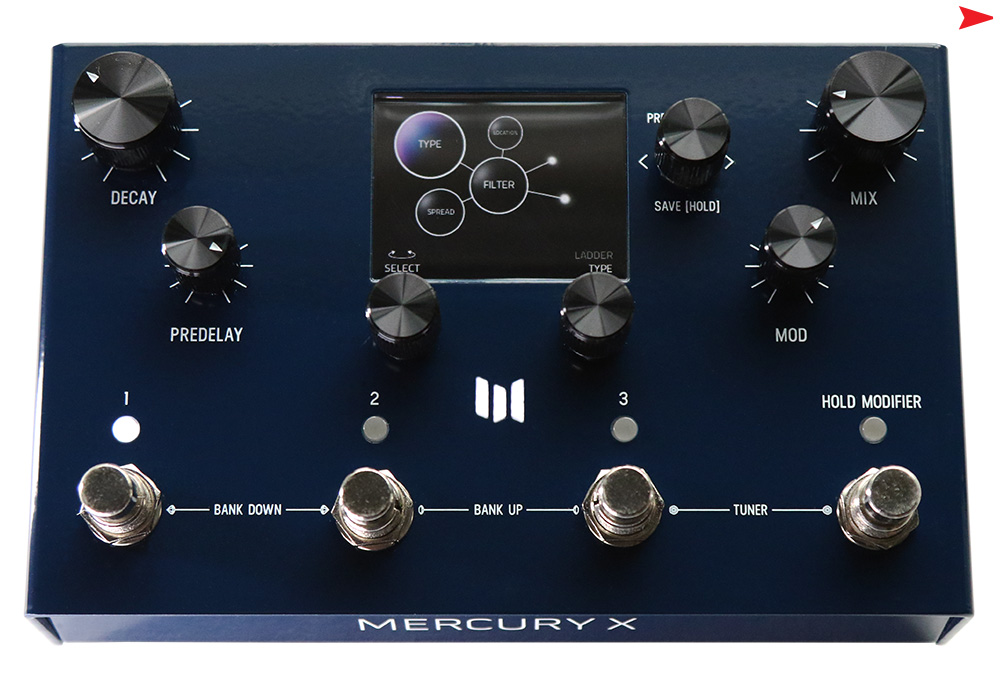

For a limited time only! Up to 80% off all Waves Bundles. PLUS click the banner above or the Go button for an additional 10%! This is Waves best deal yet! Get yours today before this special ends! Go!
First and foremost, the reverb algorithms, in their purest form without any additional modifiers, “are glorious.” For some reason, Meris chooses to label their eight algorithms as Structures, but for the sake of clarity, we’ll continue to describe them as algorithms. The eight different algorithms Meris offers are Cathedra, Ultraplate, 78 Room, 78 Plate, 78 Hall, Spring, Prism and Gravity. Meris hasn’t broken completely new ground on these reverbs, Ultraplate and Cathedra are lifted from the Mercury 7 pedal, and the 78’s are from their collaboration with Chase Bliss on their CXM 1978 pedal. For those who don’t need the dancing faders on the CXM, the Mercury X can not only be scored for $300 less, but it’s also a lot more versatile. Meris did develop three new algorithms for the Mercury X, including Gravity, a granular take on reverb that chops up a sound into segments and stretches it along a timeline. Meris targets this algorithm for pads, but our techno producer commented on how “well Gravity works on spoken word samples.”
“Prism is a wonderful algorithm for crafting signature spaces…”
Spring is Meris’ take on vintage spring reverb tanks and provides a high-resolution twang to source material. Our techno producer found it served as a different kind of phaser flavor for percussion and hard hitting sounds, while our guitarist found its character worked well with finger picking and slide. Sound designers will find that Prism is a wonderful algorithm for crafting signature spaces. Based on geometric principles and allowing users to define specific size, distance and reflections, Prism “really allows you to get your hands dirty with more parameters than you can even imagine.”
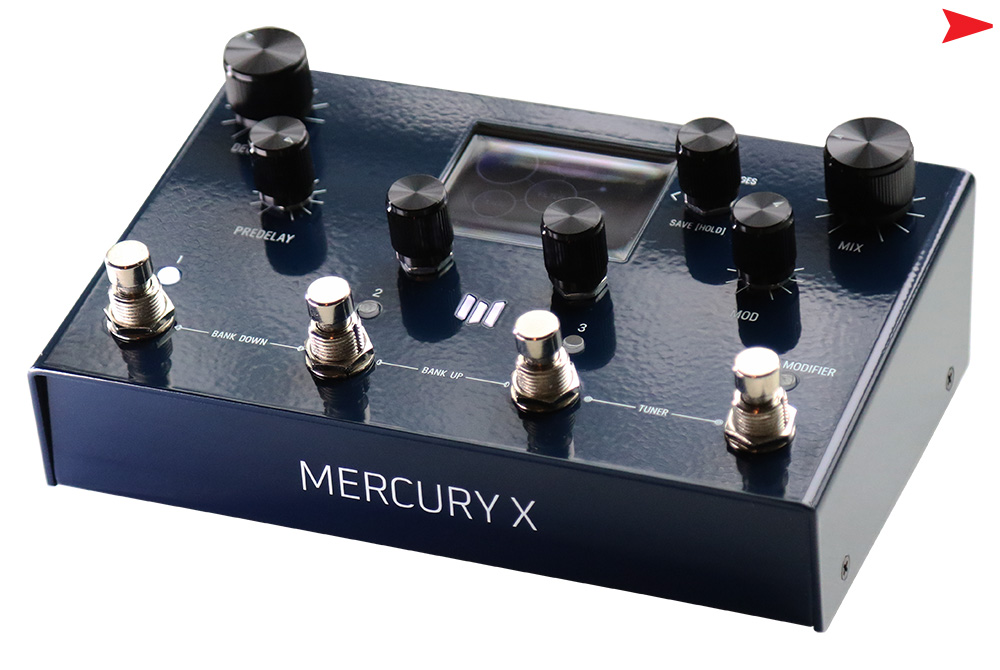
Right Side View Shows Off The Mercury X’s “world-class” build quality
Now these excellent algorithms could stand on their own in a guitar pedal and easily sell for $300, even in the current overly saturated reverb guitar pedal market. However, Meris soaks all this glorious reverb in their modular architecture, and that’s where things get “mind blowing.” Again, the guitar pedal format may put off some musicians since they won’t realize “how much there is to tweak,” but if you’re “open-minded” you’ll “be rewarded.” Like the LVX, the presets are really tailored to guitar and not synths, samples and other electronic music elements. In fact, our modular synthesist “wasn’t very impressed” with the presets when he first got the Mercury X, but that “changed very quickly” once he started exploring Jinna Kim’s Bubble graphical user interface. It may be initially foreign to guitarists, and somewhat “intimidating,” but once you understand the workflow, “it’s very easy to use.” That said, the Mercury X can be used in Text Mode (without the bubbles), but “what’s the fun in that?” For those unfamiliar with Jinna Kim, she’s the wife of Terry Burton who along with Angelo Mazzocco are the founders of Meris. Each bring a synergetic skill set to the company that has allowed them to deliver one great product after another. Please read our Merix LVX review where you can discover a lot more about the founders and the company. —Ed.)

The Meris Mercury X has dozens of hidden talents that you can only unearth if you have the patience to explore everything this incredible pedal has to offer…
Before we delve into the Mercury X’s engine, let’s take a look at the controls. The Mercury X has the same layout as the LVX with four foot pedal buttons, four LED buttons above them and seven knobs. The four LED knobs perform the same duties as the foot switches, but are included for desktop users who don’t necessarily want to battle with with the stompers, a savvy choice by Meris. A large Decay knob starts us off in the upper left corner, followed by a dedicated PreDelay knob just underneath to the right. Next, you’ll find the three Controller knobs, C1 and C2 underneath the display screen, and C3 on the right hand side. These knobs not only rotate, but also click to select options. Finally, you’ll find the smaller Mod knob and larger Mix knob on the right. The first three foot switches/LED buttons allow you to select one the 99 presets/user slots housed in 33 banks. Simultaneously pressing three and four, brings up the built-in tuner and the fourth switch selects the behavior of the Hold parameter, which can either be a Freeze function or can ignite a temporary attribute based on the preset.
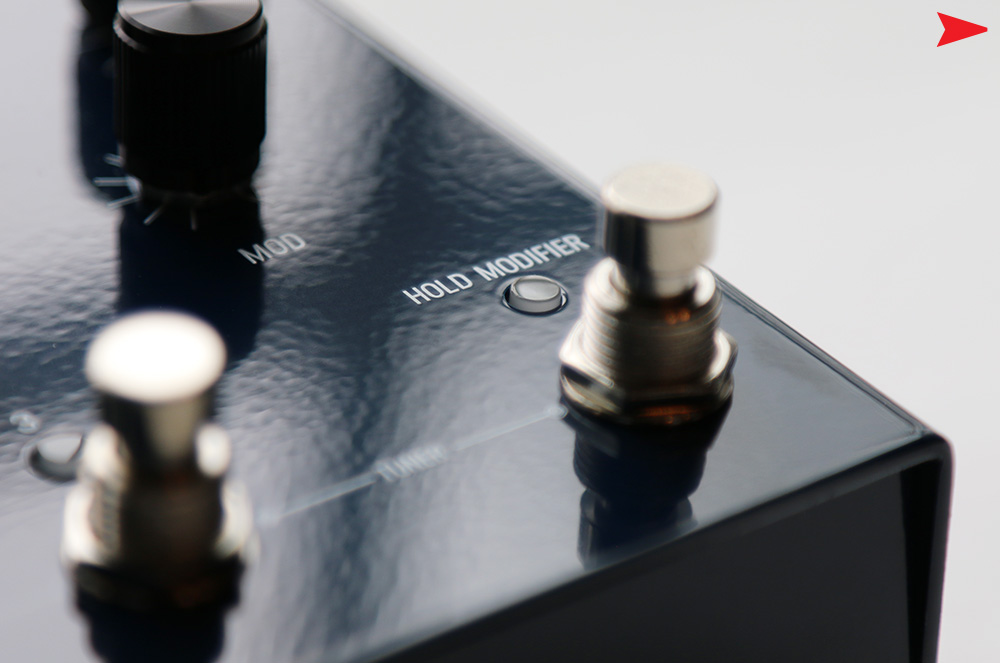
Urban Rhythm Returns With Defining Album
Urban Rhythm has released Backstory, an exciting new album that demonstrates why he is the King of Acid ‘n’ Bass. Standouts include the huge hit, “Linus & Lucy”, Urban’s cover of the famous Peanuts theme song, as well as “Dead Pixel”. Check out out on all the major streaming platforms below:
Meris Mercury X Features:
- Eight Reverb Algorithms: Ultraplate, Cathedra, 78 Room, 78 Plate, 78 Hall, Spring, Prism and Gravity
- Premium analog signal path and 24-bit AD/DA w/32 bit floating point DSP
- Premium Analog Devices JFET input section
- Expanded 2.54 secs of Stereo Predelay with modular Feedback Routing Location
- Advanced ARM Processor
- Configurable Reverb Structures, Types, and Processing Elements
- Color Screen based User Interface
- Expressive Hold Modifier Switch for on the fly control
- 99 Preset Locations in 33 Banks
- Favorite Preset Bank for instant access to three Favorite presets
- Tuner with configurable Reference and Output mode
- Innovative Modular Reverb System architecture
- Deep Modifier Section lets you route control signals to processing parameters
- Independent Stereo Freeze alongside reverb
- Gate Envelope Controls for every reverb type
- Processing Elements: 79 Chorus, Vibrato, Vowel Mod, Tremolo, Hazy Lo-Fi and more
- Selectable Note Divisions for each channel of the stereo Predelay
- Digitally controlled Analog mix bus
- Stereo input and output
- Switchable input/output headroom level for Instrument or Synthesizer / Line levels
- MIDI In and Out/Thru over standard MIDI Din Jacks
- Assignable Expression Pedal control for multiple parameters simultaneously
- Dedicated Expression Pedal Jack
- MIDI implementation for Continuous Control Parameters
- MIDI Preset Send and Receive
- MIDI beat clock synchronization
- Dimmable screen and logo light
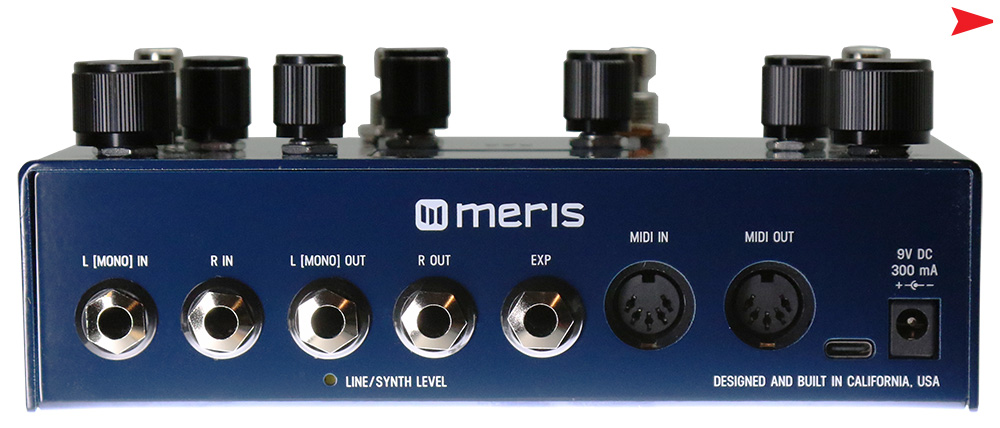
Back view of the Meris Mercury X Reverb Effects Guitar Pedal
Meris Mercury X Specifications:
- 24 bit A/D and D/A Conversion
- 32 bit floating point DSP
- Sample Rate: 48000 Hz
- Input Impedance: 1 Meg Ohm
- Signal-To-Noise-Ratio: 115 dB Typical
- Frequency Response: 20Hz-20kHz
- Max Input Level: +9 dBu (instrument level setting) / +12.5 dBu (line/synth level setting)
- Power: 9V DC center-negative, 300mA, 2.1mm jack
- Bypass Selectable: True Bypass (Relay) or Analog Buffered Bypass
- Dimensions: Width – 7.25″ / Length – 4.5″ / Height – 2″
- Weight: 24 oz


The easiest way for electronic musicians to get their music onto Spotify, Apple Music, iTunes, Amazon Music, Tidal, Instagram, Facebook, TikTok, Pandora, Twitch & much more! Click the banner above or the Go Button to save 7% off of your signup! Go!
The Meris Mercury X doesn’t want for connectivity with full-sized MIDI DIN IN/OUT connections; 1/4″ Left In / Right In; 1/4″ Left Out / Right Out; 1/4″ Expression pedal input; USB-C connection (for firmware updates); and a 300mA DC 9v connection (power supply is not included). Meris baked in a lot of exciting modulation with the expression feature, but when used in connection with the Hold button, things can get “just bonkers,” and is something that makes this pedal quite special.
One of the Mercury X’s hidden talents – and there are many – is that it can actually be a standalone stereo delay pedal. With two-and-a-half seconds of predelay, and independent timing on each channel, you can “create bouncy, MIDI sync’d rhythms.” Typically, predelay simply stalls the time the effect takes hold on the sound, which is great if you want your opening notes to hang before the wash of reverb scatters it to the wind. But with Meris’ modular structure, including signal chain position (see signal flow image below), and the interplay of each element, it’s easy to “take just average sounds and loops to new heights.” So let’s get into exactly what you can achieve with the Mercury X’s parameters.
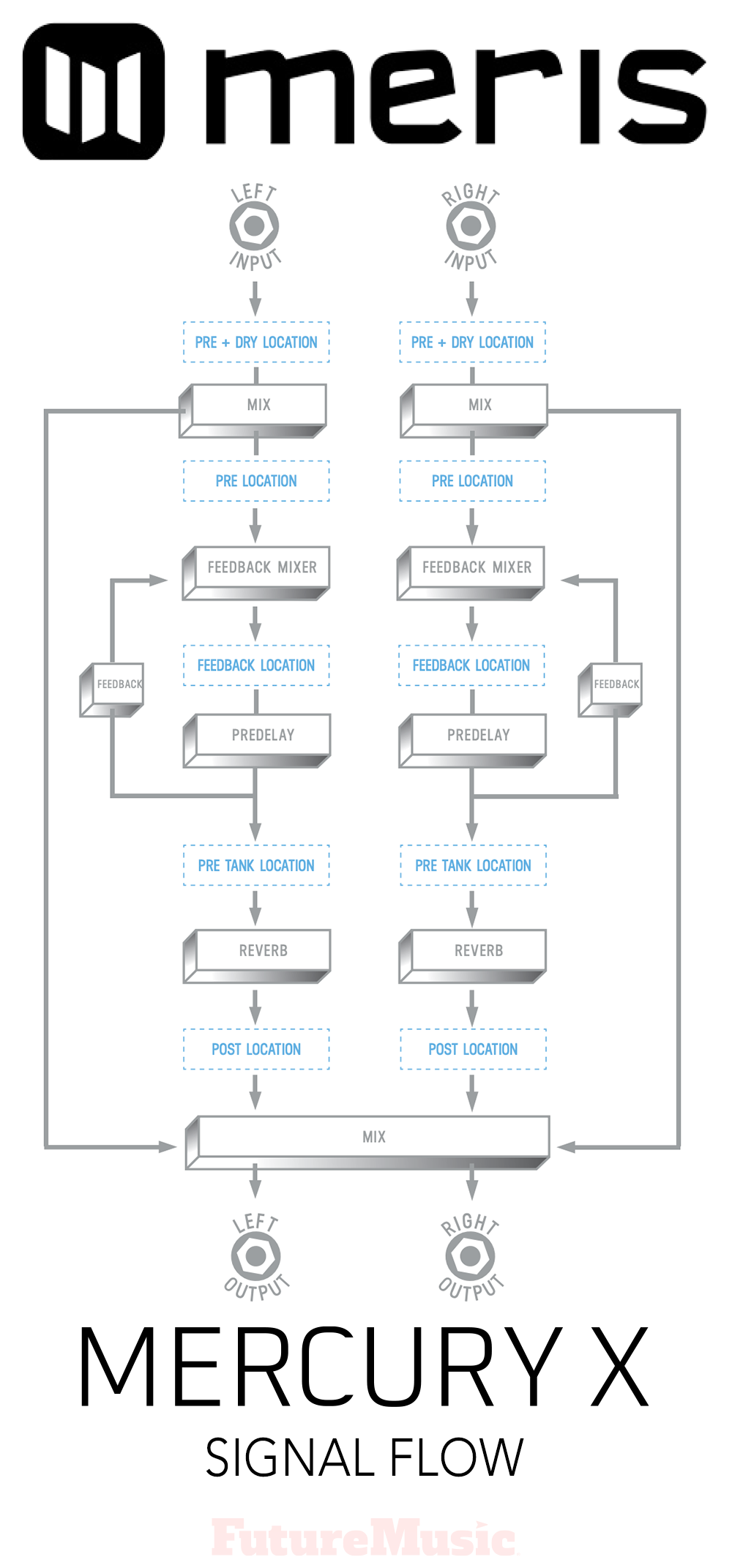

Clicking the Preset/Pages C3 knob launches the Bubble interface that is reminiscent of a molecule illustration with one main bubble (nucleus) surrounded by other bubbles (electrons). You can rotate the bubbles using the C1 knob and change any of the highlighted bubble’s options by using the C2 knob. Again, it takes a minute to grasp, but once you do, it’s very intuitive. The first bubble highlighted is Structure. Here you can choose one of the Mercury X’s eight algorithms. Next is Gate Delay, Gate Hold, Gate Attack, Poly Blend, Diffusion, Pitch Mix, Pitch, Mod Depth, Mod Speed, High Frequency, Low Frequency and finally Decay. Think that’s a lot of parameters? That’s only the first page!!
On page two – Dynamics – you can mod the Mix, Gain, Mix, Location, Compressor, Limiter, Swell, Diffusion and Freeze, where you can infinitely sustain the current sound. Let’s take a moment to look at Location. Here you have many options as to where you want to place the attribute: Pre, Pre+Dry, Feedback Loop, Pre Tank and Post (refer to the signal flow image above). Then there are the preamp models, Tube, Volume Pedal, Transistor and Optical. Now you can add the Modifiers: LFO speed, Division, Shape, Amount and Assignment. Oh, and there are two LFO’s, A and B. How about Sample and Hold, Envelopes. Hold and the onboard sixteen-step Sequencer? We could be here for days going through all the different ways you can tweak the MercuryX. D-a-y-s…
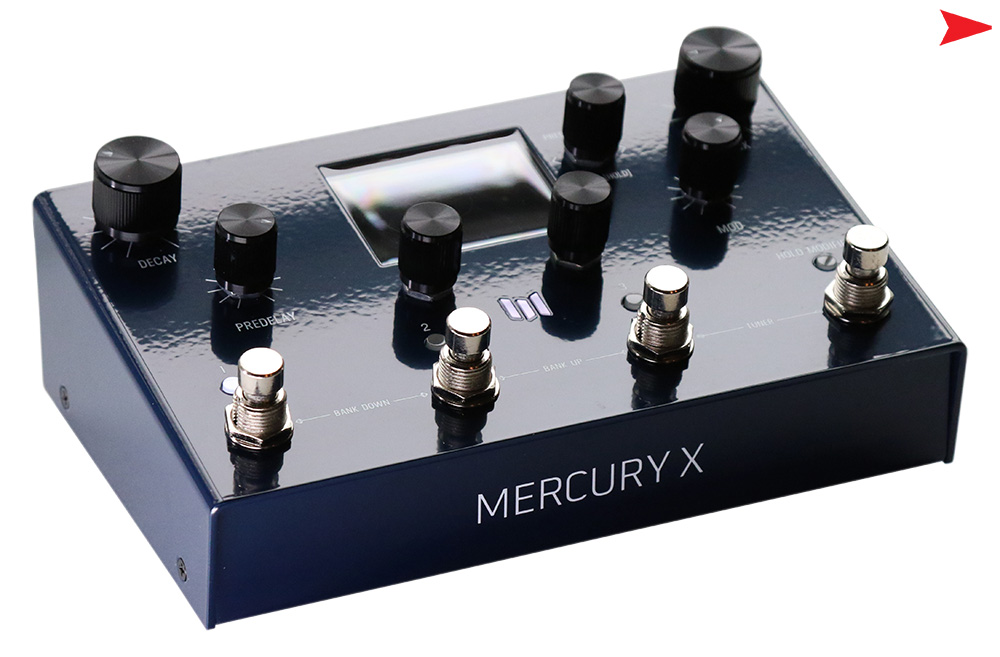
There are a few other pages to spotlight. First is the dedicated Expression pedal page. Remember when we mentioned how powerful the Expression Pedal and Hold button were a while back? Well, Meris dedicates an entire page to how you can use the Expression pedal to control a dozen or so parameters, including any of the Modifiers (LFO’s, S+H, Sequencer, etc.). There is also a standalone Filter page where you can select the type of Filter you want to employ, Ladder, Parametric and State Variable (same one used in the Enzo pedal); the type, Bandpass, Lowpass and Highpass; the Frequency range, based on filter type, as well as Resonance. Our techno producer discovered that some of the Filter attributes weren’t responding to MIDI control messages in Apple’s Logic DAW, but that may be attributed to having a pre-production model to review.
There is a Pitch page for selecting the type of pitch effect. Poly Chroma is a polyphonic chromatic pitch shifter that even works on complicated chords. Lo-Fi employs an early pitch shifting technique from the Ottobit Jr. that generates modulated low fidelity voices. Microshift is another lo-fi pitch effect that allows independent detuning of each stereo channel. Next are the modulators, including the Annie Lennox inspired 1979 Chorus, Tremolo, Vibrato and Hazy, yet another lo-fi effect for tape-worn flavors. Plus, Vowel Mod, a modulated filter bank that recreates seven different short and long vowel sounds. Finally, there is a Global page for setting the MIDI channel, selecting the GUI (Bubbles or Text), Noise Gate, Tempo and other universal settings.
Now you don’t get this depth and quality by cutting corners. The Meris Mercury X is powered by an advanced ARM processor to ensure the hardware can keep up with all the software demands. The analog signal path consists of high-end components utilizing 24-bit Analog-To-Digital / Digital-To-Analog conversion with 32 bit floating point DSP and a 48000 Hz sample rate. The medal enclosure is “solid and feels planted on your pedalboard or desktop.” The paint job is beautiful, consistent and with a “luster that screams quality.” The “knobs are absolutely world-class” and the stomp switches “feel like they’ll last a lifetime.”

Conclusion
There have been a number of excellent guitar pedals that have come out this year, but nothing even comes close to the Meris Mercury X in terms of build quality, sound quality and depth. Nothing. If you’re looking for a special reverb pedal that can do practically everything you could ask of it, there’s nothing that compares to the Meris Mercury X. Highest Recommendation.
Meris Mercury X Rating: 100%
Cheers:
+ Unbelievable Sound Quality
+ World-Class Build Quality
+ Incredible Value
+ Manual
+ Connectivity
+ Depth
Jeers:
– Power Supply Not Included

The Meris Mercury X costs $599 and is available now.
The Future: Just a phenomenal company that continues to hit one home run after another. The only recommendation we can make is create even better presets in the next firmware release. This way potential customers who test drive the Mercury X in stores can truly hear it’s full potential.








